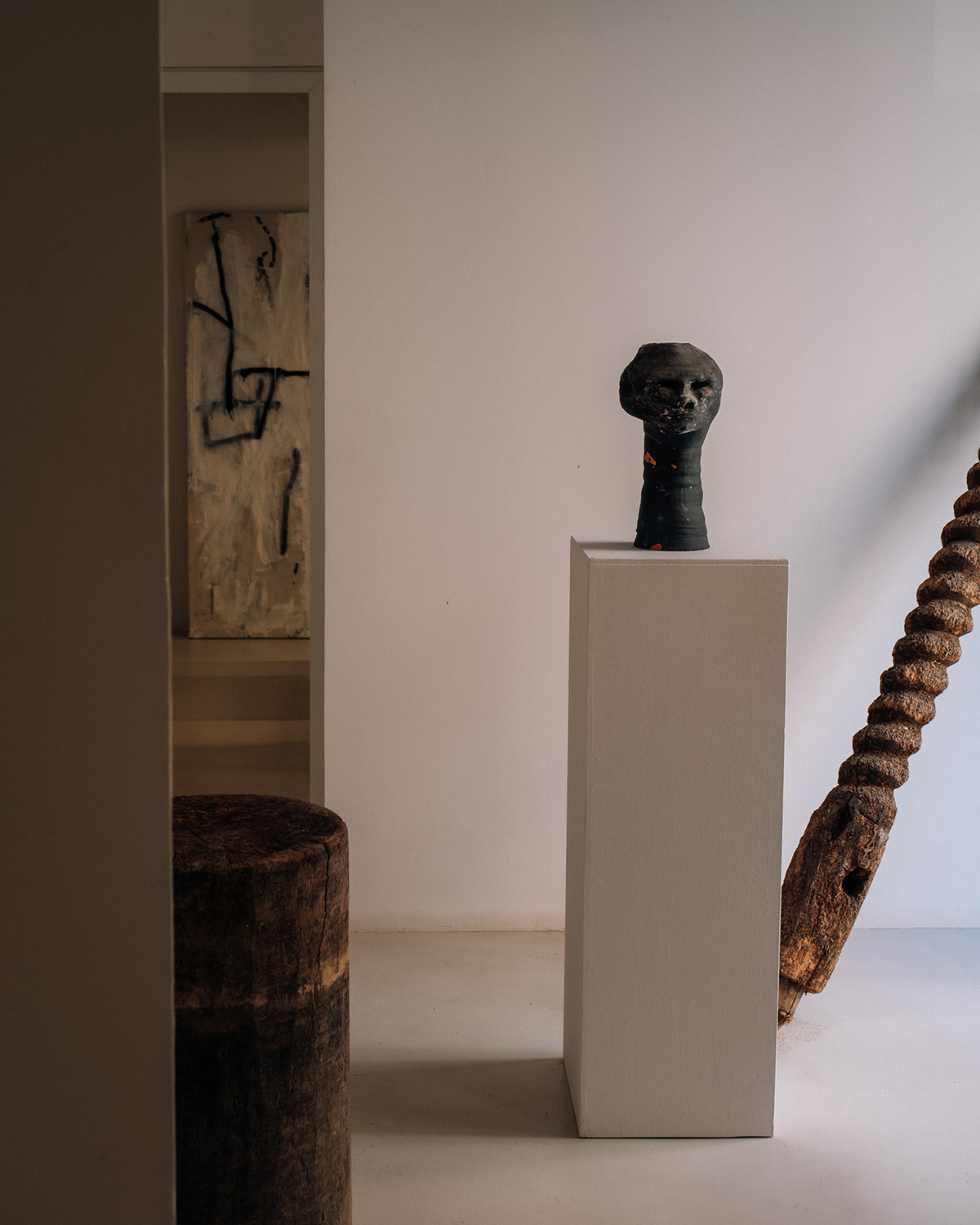
Every form of poetry
Gabriel Escámez
Gabriel Escámez embodies everything one can attribute to a total artist. He possesses genius, sensitivity, charisma, overflowing energy, and great determination to achieve the desired outcome in each of his projects. When you are near someone with the tenacity and talent he possesses, their energy rubs off on you, which drives you to strive for excellence.
We find him at Cobalto Studio, the space that Gabriel and his team inhabit in Barcelona. A sort of art gallery, creative workshop, sensory archive, and office adorned with objects that are as emotive as they are beautiful. The entrance greets us with intriguing pieces of noble and pure materials. To the left, a long table is positioned in front of the glass facade, activating a dialogue between the indoors and outdoors. At the back of the studio, a resting area or small lounge leads to the more functional space. A wardrobe runs along the area of work tables. A hat, several drawings, photographs, ceramics, and other unique objects rest on top of it.
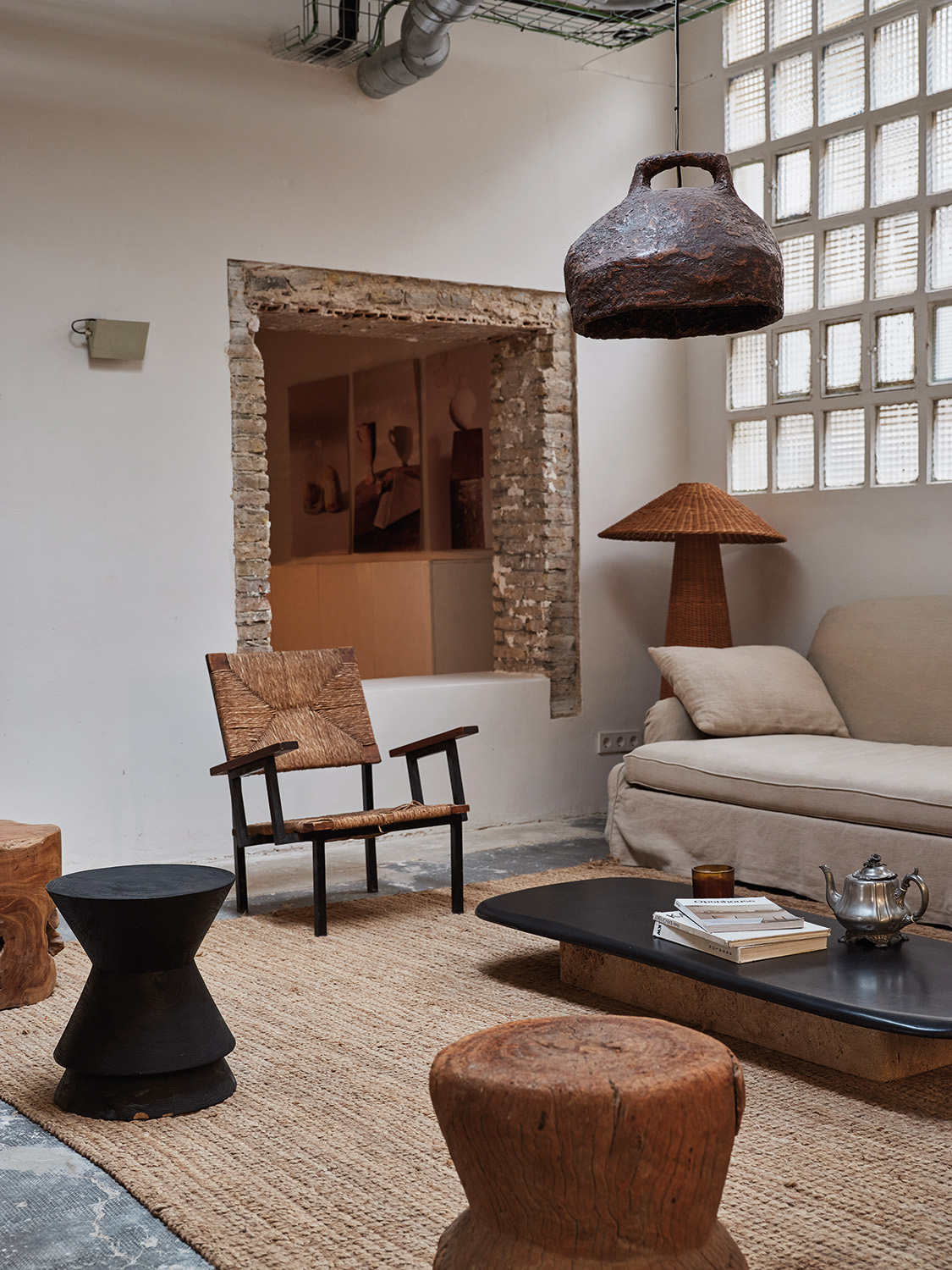
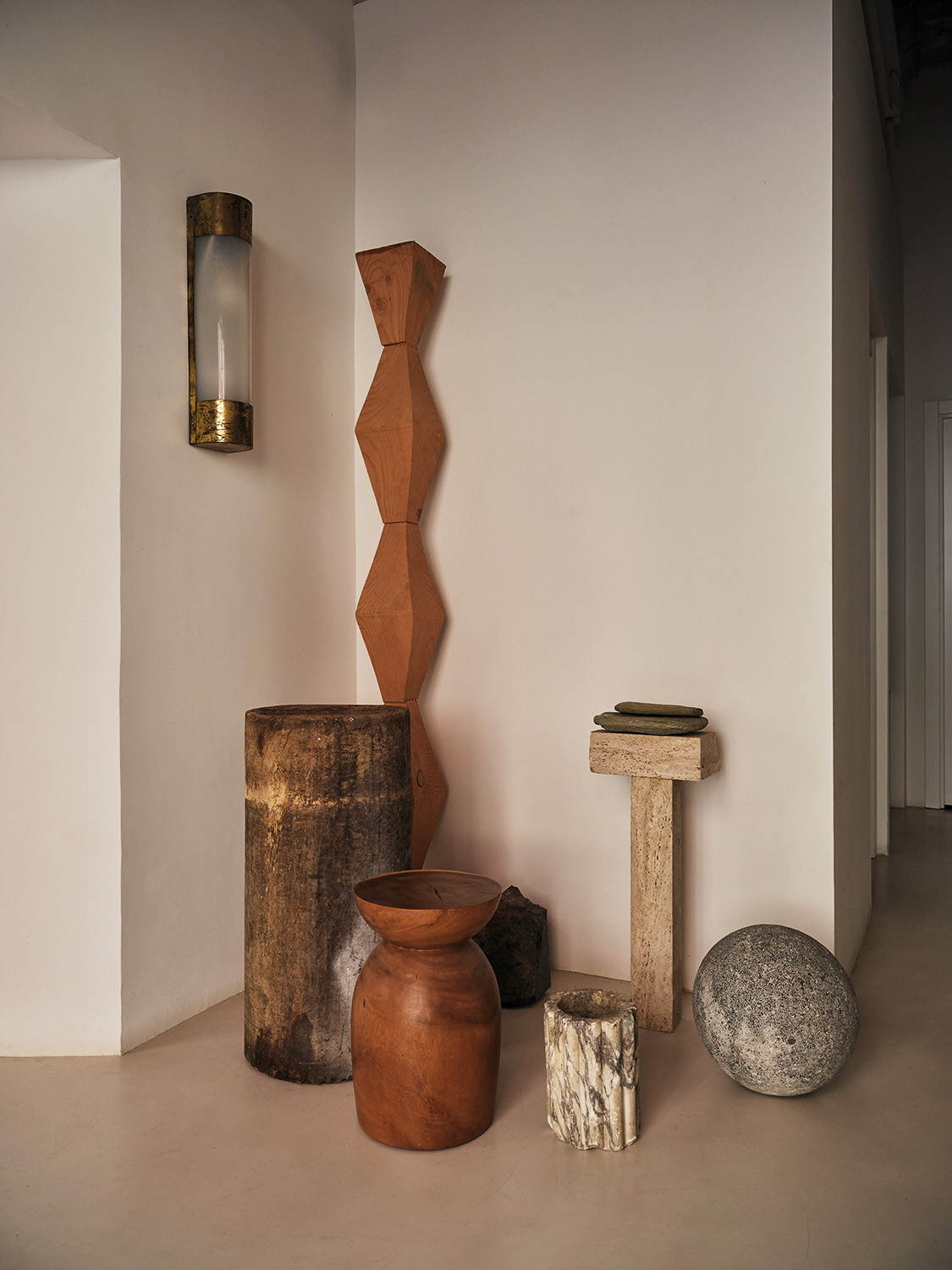
Gabriel shows us some of the items he has brought to add a personal touch to the article: the guitar that once belonged to his father, his unintended collection of white Vans sneakers, and some effects that are part of his particular creative universe. His enthusiasm for including them in the selection is more than noticeable. At the end of our visit, he decides that one of the ‘artistic installations’ he has arranged for the photos, will be exhibited at Cobalto Studio for at least a few hours. “Could be fun, right?” he asks rhetorically in a question that summarizes all his persona at once.
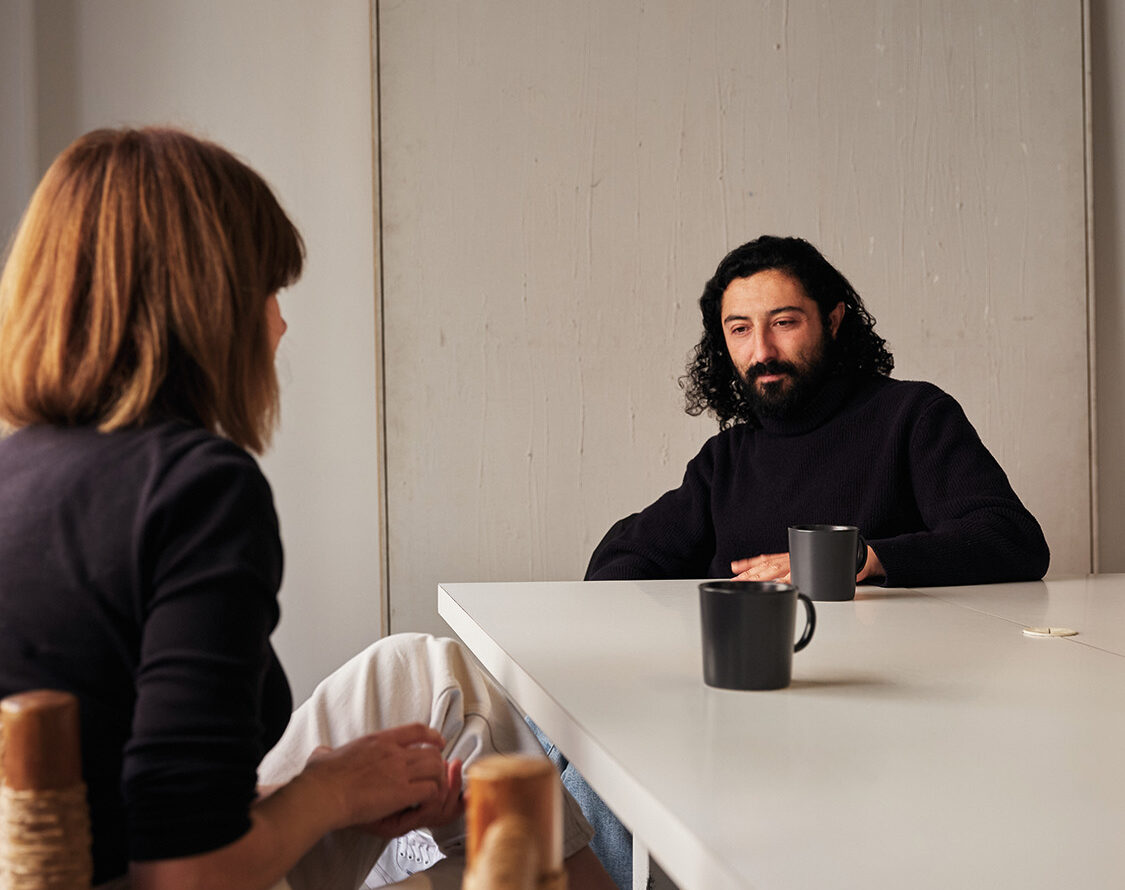
After photographing the objects chosen for this ‘Selected by,’ we sit down to chat over a cup of coffee around the majestic table that welcomes Cobalto Studio’s visits. Relaxed, delighted by the soft winter sun streaming in through the windows, we converse about poetry, music, work and life in a brief but exquisite gathering.
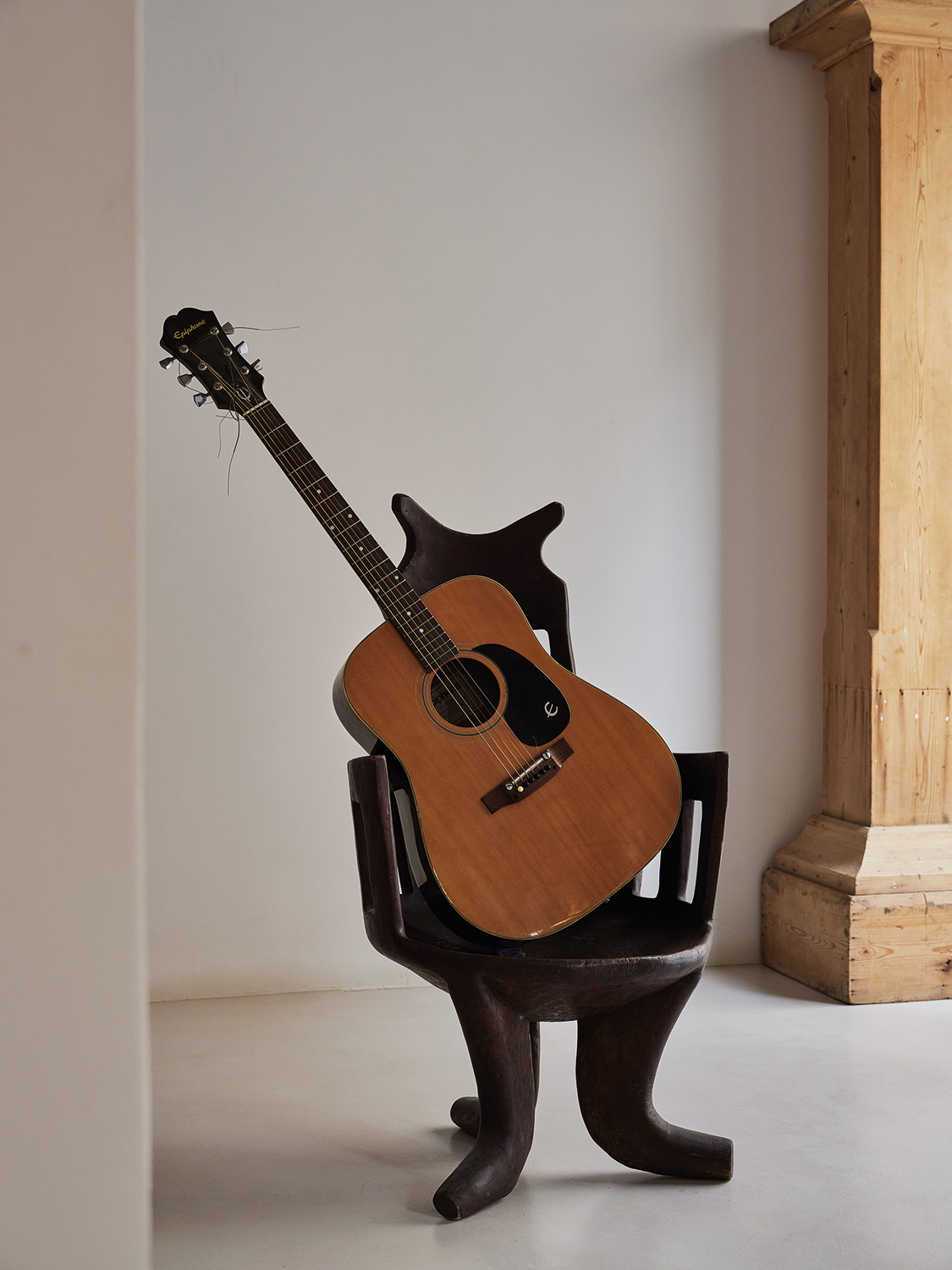 MY FATHER'S GUITAR. I started again with lessons and wanted to play this specific guitar. It symbolizes him (who is no longer here) and is still part of his presence and his enthusiasm that accompanies me.
MY FATHER'S GUITAR. I started again with lessons and wanted to play this specific guitar. It symbolizes him (who is no longer here) and is still part of his presence and his enthusiasm that accompanies me. 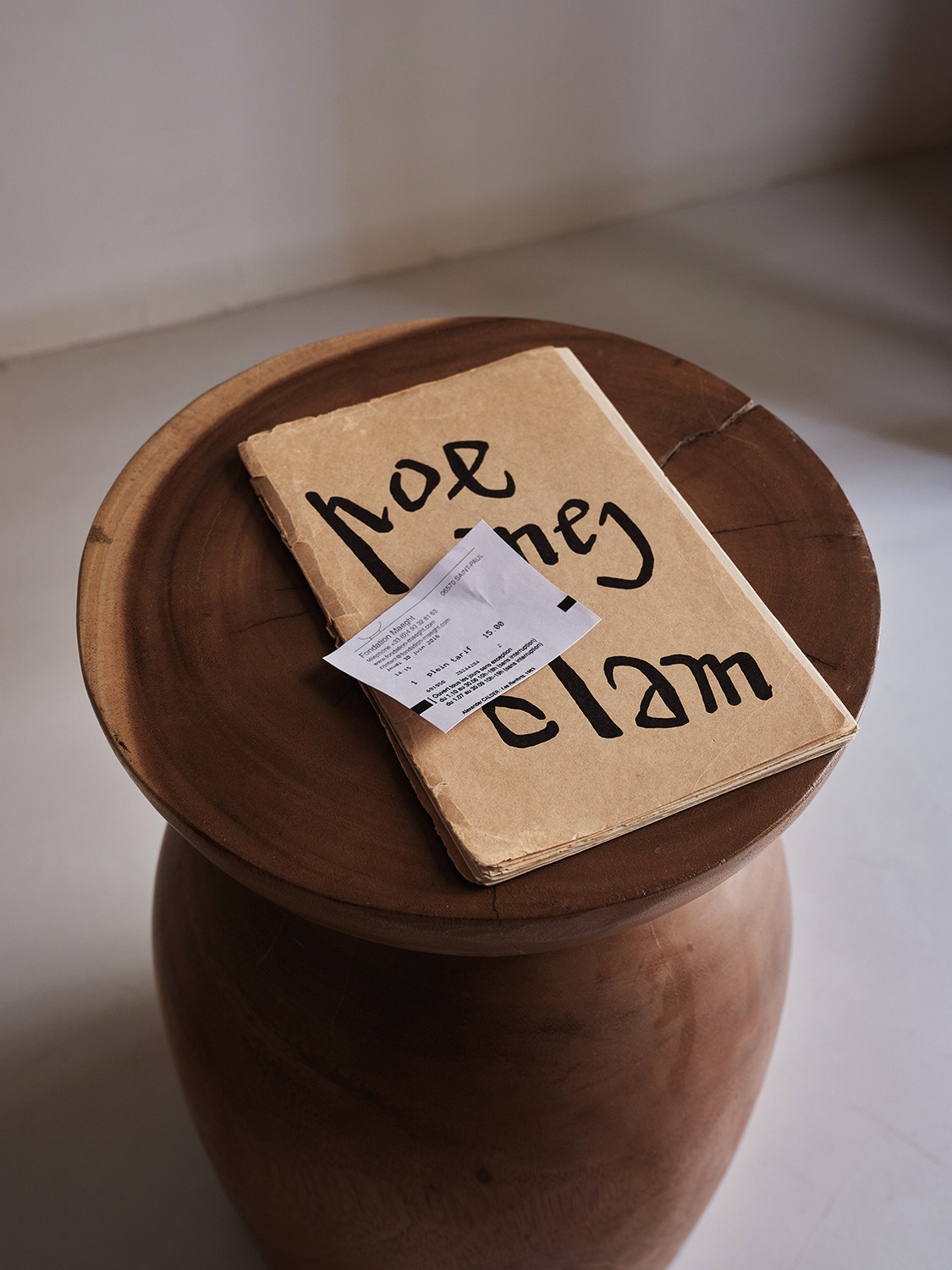 FONDATION MAEGHT TICKET. I think it's the most barbaric and beautiful place I've ever been. I would love to live there. I like the materiality, the place, the vegetation, the art pieces... everything. Designer JOSEP LLUÍS SERT. Year INAUGURATED IN 1964.
FONDATION MAEGHT TICKET. I think it's the most barbaric and beautiful place I've ever been. I would love to live there. I like the materiality, the place, the vegetation, the art pieces... everything. Designer JOSEP LLUÍS SERT. Year INAUGURATED IN 1964. 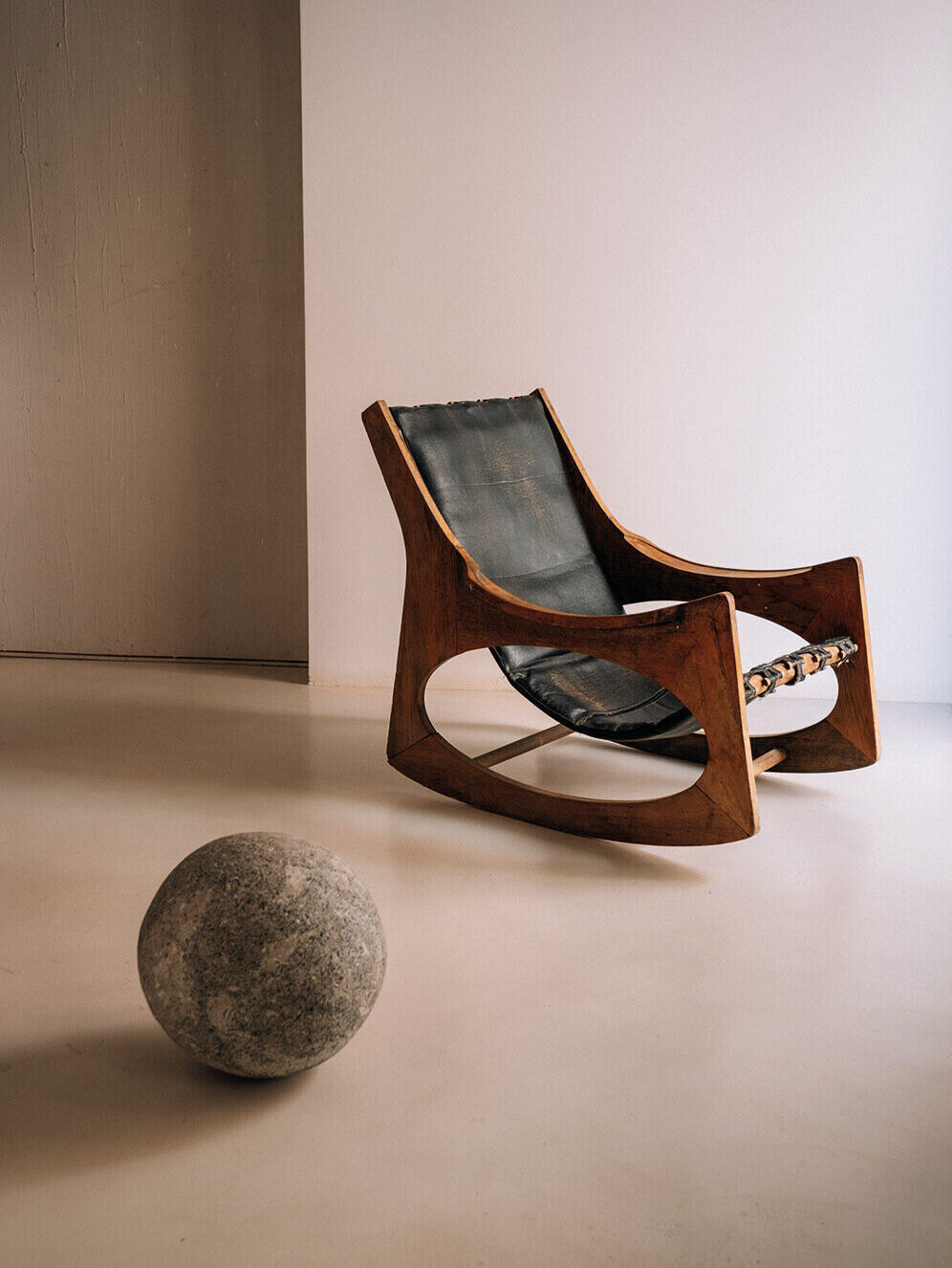 "TARTERA" ROCKING. This rocking chair is a harmonious fusion of two symmetrical side pieces, seamlessly integrating the backrest, arms, legs, and tilting arch into a fluid and unified form. The cohesiveness of these elements is accentuated by an oval aperture at the center, creating the illusion of a singular wooden plane. it is designed by Jordi Vilanova i Bosch (1925-1998), a renowned Catalan interior designer, initially honed his craft as a cabinetmaker before delving into furniture design. In 1960, he established the interdisciplinary collective "La Cantonada" and went on to pioneer the Catalan art publication "Art Questions" in 1967. Designer JORDI VILANOVA I BOSCH. Year 1966.
"TARTERA" ROCKING. This rocking chair is a harmonious fusion of two symmetrical side pieces, seamlessly integrating the backrest, arms, legs, and tilting arch into a fluid and unified form. The cohesiveness of these elements is accentuated by an oval aperture at the center, creating the illusion of a singular wooden plane. it is designed by Jordi Vilanova i Bosch (1925-1998), a renowned Catalan interior designer, initially honed his craft as a cabinetmaker before delving into furniture design. In 1960, he established the interdisciplinary collective "La Cantonada" and went on to pioneer the Catalan art publication "Art Questions" in 1967. Designer JORDI VILANOVA I BOSCH. Year 1966.Do you remember the first time you acquired something with a collector’s consciousness?
I don’t think I’ve ever bought with the intention of collecting, just something I loved at that moment and wanted to have. There’s something very romantic and poetic about how things age. It’s not just the piece itself but its evolution. The study or appreciation of its aging process. There are nuances that can’t be achieved otherwise.
What is the main characteristic that attracts you to an object?
I believe it’s a matter of proportion. Volume is essential. Then also the story it may carry: the patina, the aging, and the materiality.
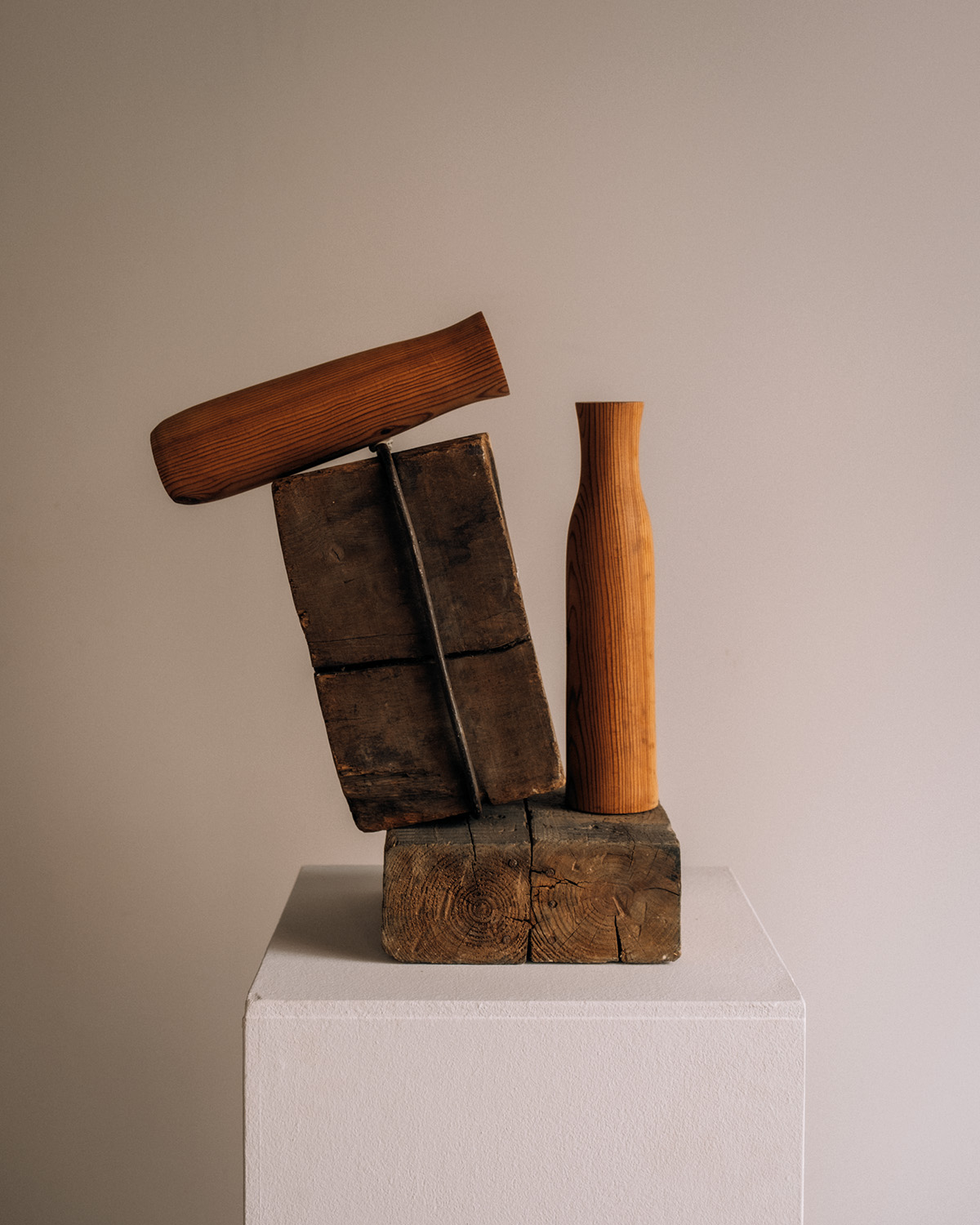 SMALL WOODEN PIECES. These small pieces made from wood of old press mills are so beutiful in their simplicity. I used then quite a lot to compose still lifes as the one in this images, hence their numbering.
SMALL WOODEN PIECES. These small pieces made from wood of old press mills are so beutiful in their simplicity. I used then quite a lot to compose still lifes as the one in this images, hence their numbering.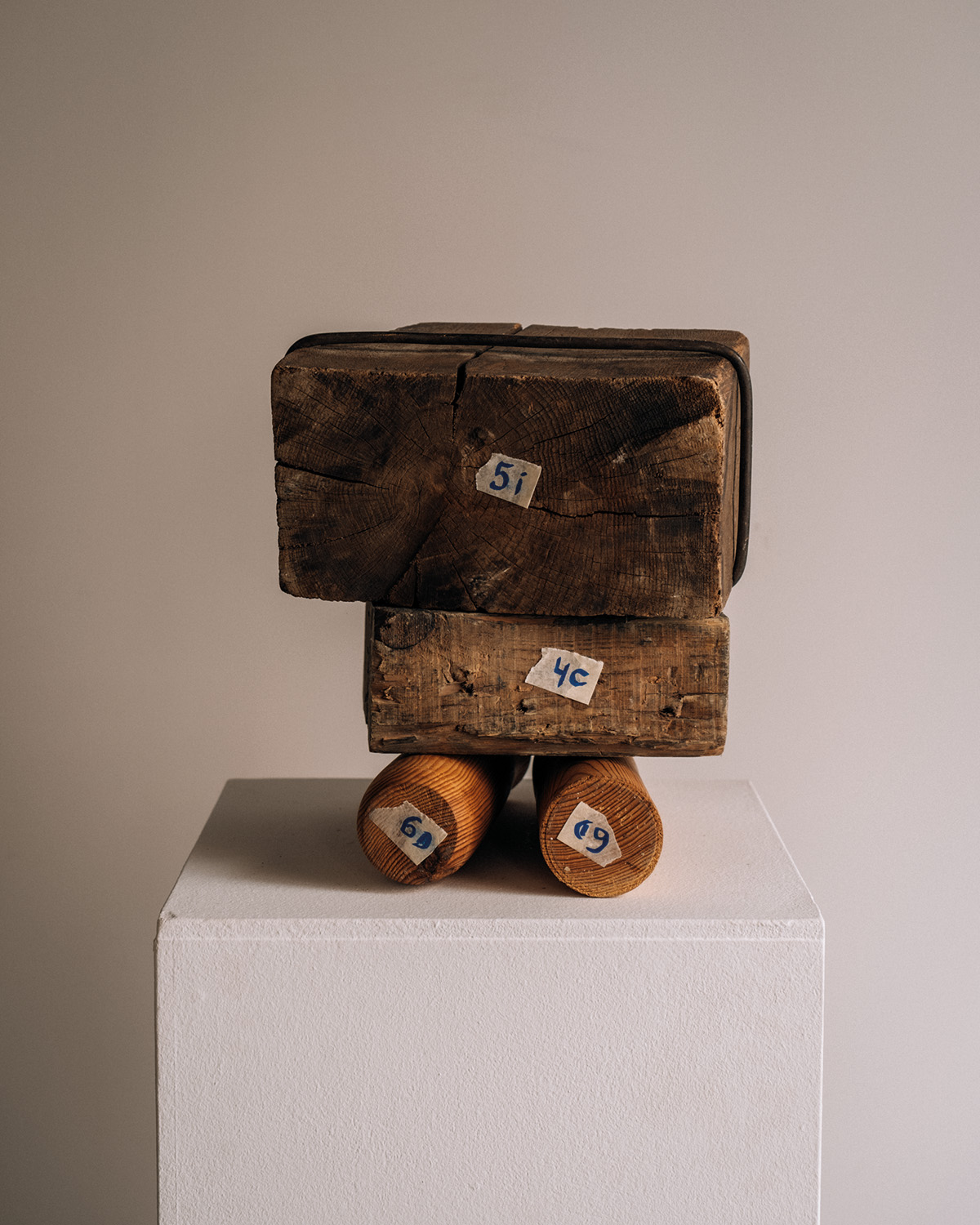
Regarding the selected objects for this article, tell us about the Vans. What attracts you to them? When and how did you decide to bring this collection to us?
Well, I think it happens to a lot of people. When you get used to a pair of shoes and you find it impossible to stop wearing them even in inappropriate moments. You’re dressed in a tuxedo and suddenly you want to wear Vans because you can’t see yourself with any other footwear—even though I have other very interesting ones too. Thinking about how to bring the selection closer to the character, it occurred to me that this really defines me.
What can you tell us about your father’s guitar that is part of the selection?
I brought it because I started again with lessons and wanted to play this specific guitar, but in the end, I decided to go back to the piano. It’s always beautiful to have something from my father who is no longer here. It symbolizes him and is still part of his presence and his enthusiasm that accompanies me.
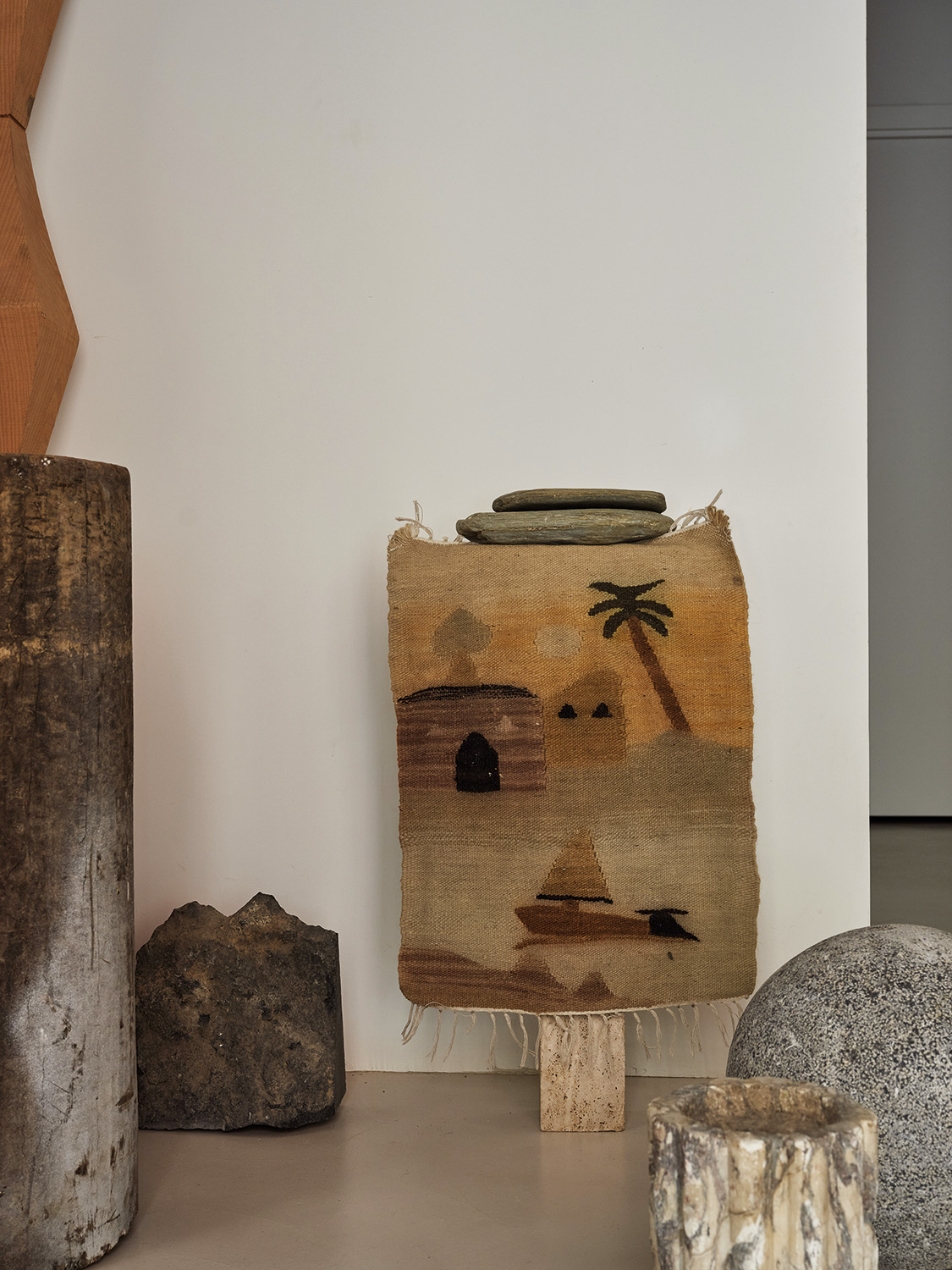 EGYPTIAN CARPET. My sister brought it to me as a gift from a trip she took to Egypt many years ago. I take care of it with great love. There is something really chaming about this small rug.
EGYPTIAN CARPET. My sister brought it to me as a gift from a trip she took to Egypt many years ago. I take care of it with great love. There is something really chaming about this small rug. 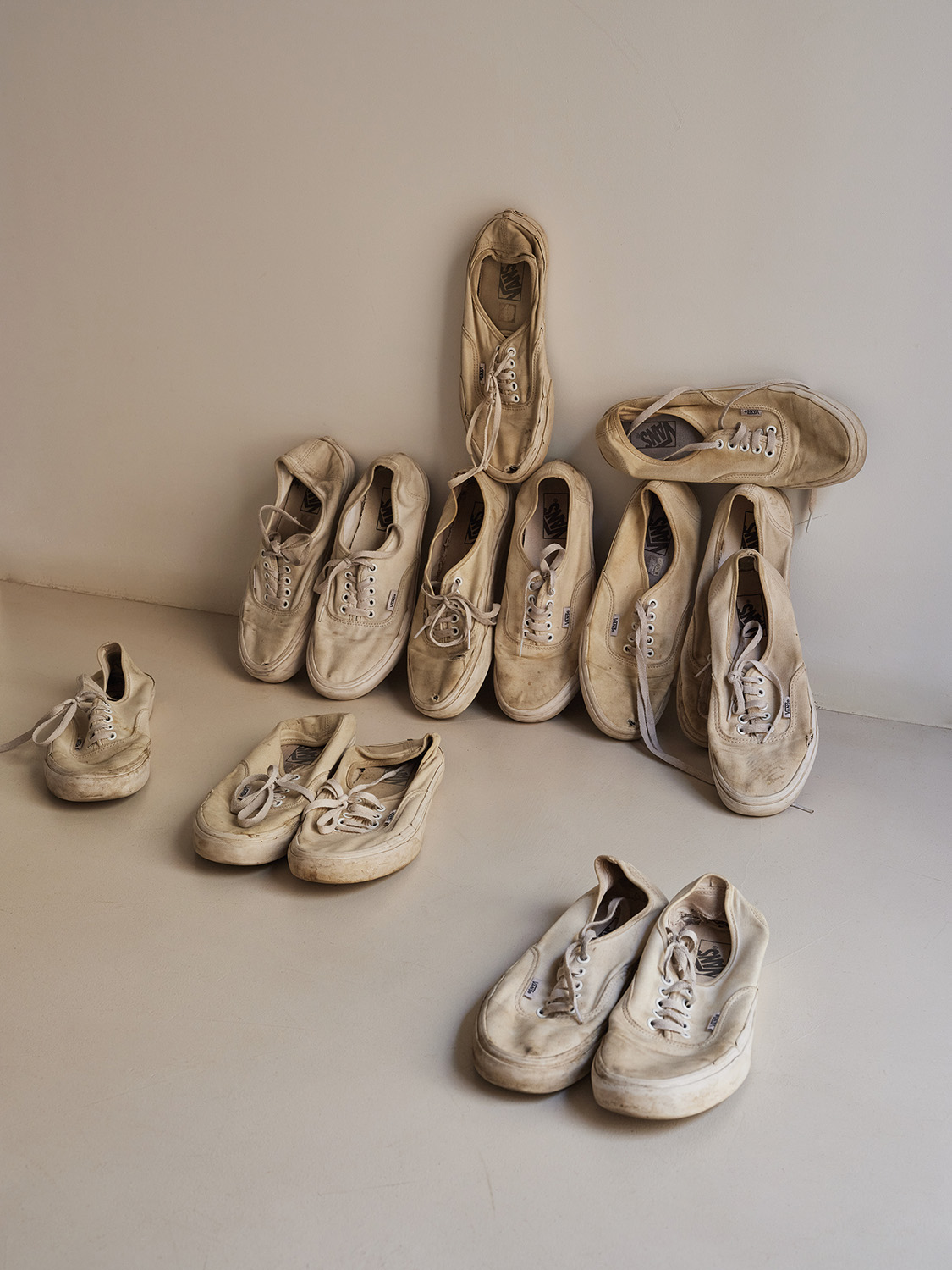 AUTHENTIC WHITE SNEAKERS. The Authentic model was the first one sold by brothers Paul, James and Gordon C. Van Doren is their humble Californinan shop back iin 1966. As I wear them almost every day, they have become a hallmark of my personality. So much so that I have come to collect them as an object of personal value. They are the simplest and most neutral footwear, which refers me to painters and a blank canvas. Designer VAN DOREN BROTHERS. Brand VANS. Year 1966.
AUTHENTIC WHITE SNEAKERS. The Authentic model was the first one sold by brothers Paul, James and Gordon C. Van Doren is their humble Californinan shop back iin 1966. As I wear them almost every day, they have become a hallmark of my personality. So much so that I have come to collect them as an object of personal value. They are the simplest and most neutral footwear, which refers me to painters and a blank canvas. Designer VAN DOREN BROTHERS. Brand VANS. Year 1966.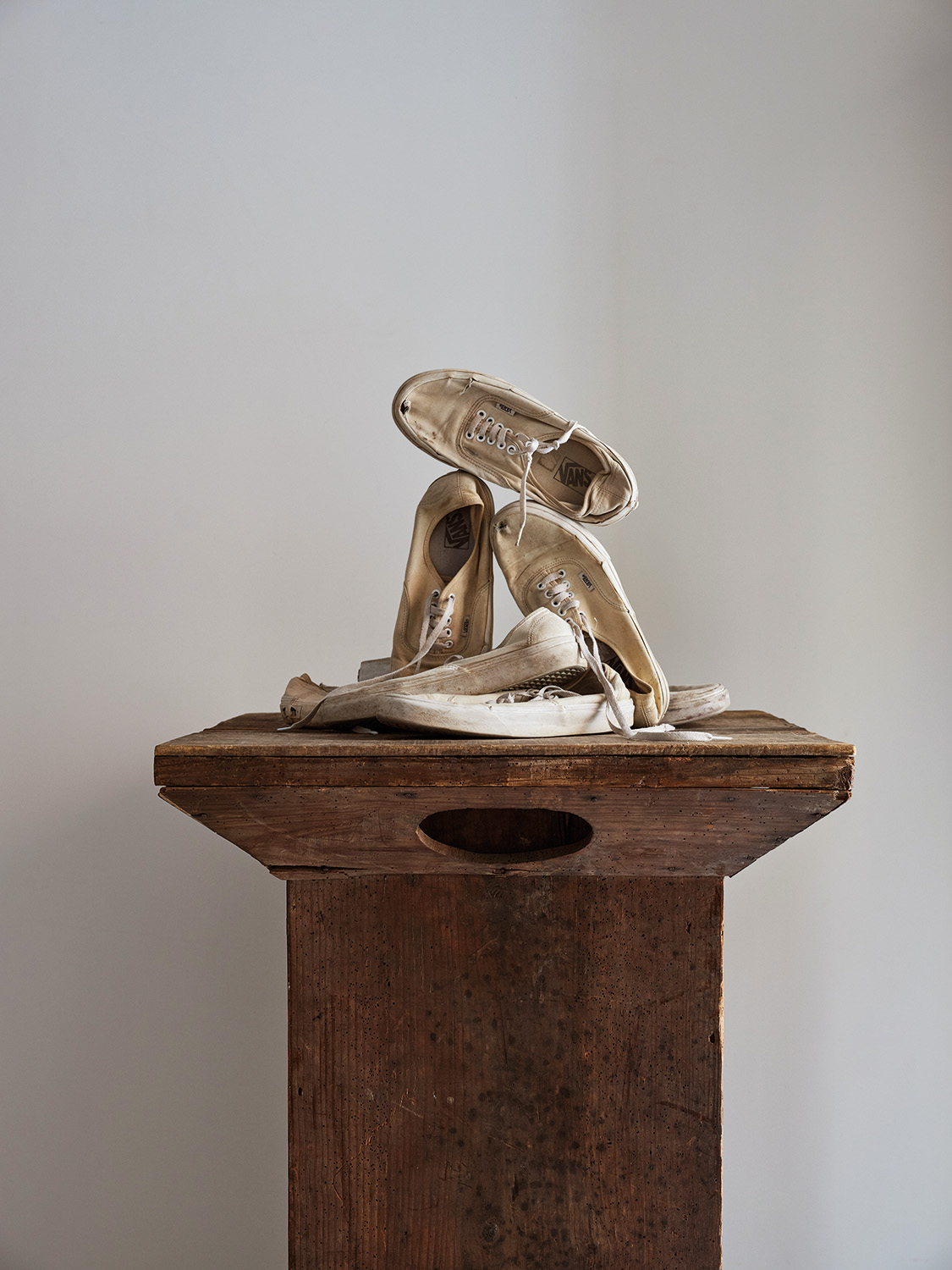
Music is also very present in Cobalto. What do you listen to the most?
What I listen to the most, and I think it also goes very much in line with what we have represented in the selection of objects, is jazz. I love everything that was done in the early 20s of African music, but derived towards jazz. It’s like a reinterpretation of cubism-brutalism. It’s cubist, but taken to the African. If I had to summarize it in just one song, it would be the ‘Love Theme From Spartacus’ by Yusef Lateef included in the Eastern Sounds album of 1961.
Have you always created spaces? Do you remember yourself, even as a child, doing so?
Yes, I made still lifes at four years old. It’s something that came to me very naturally and it’s healing because when I do it, the perception of time disappears, and I feel good.
 RING BOWL. Piece of African cubist abstraction, hand-carved in wood and with side handles. Bought at a flea market, origin and age unknown.
RING BOWL. Piece of African cubist abstraction, hand-carved in wood and with side handles. Bought at a flea market, origin and age unknown.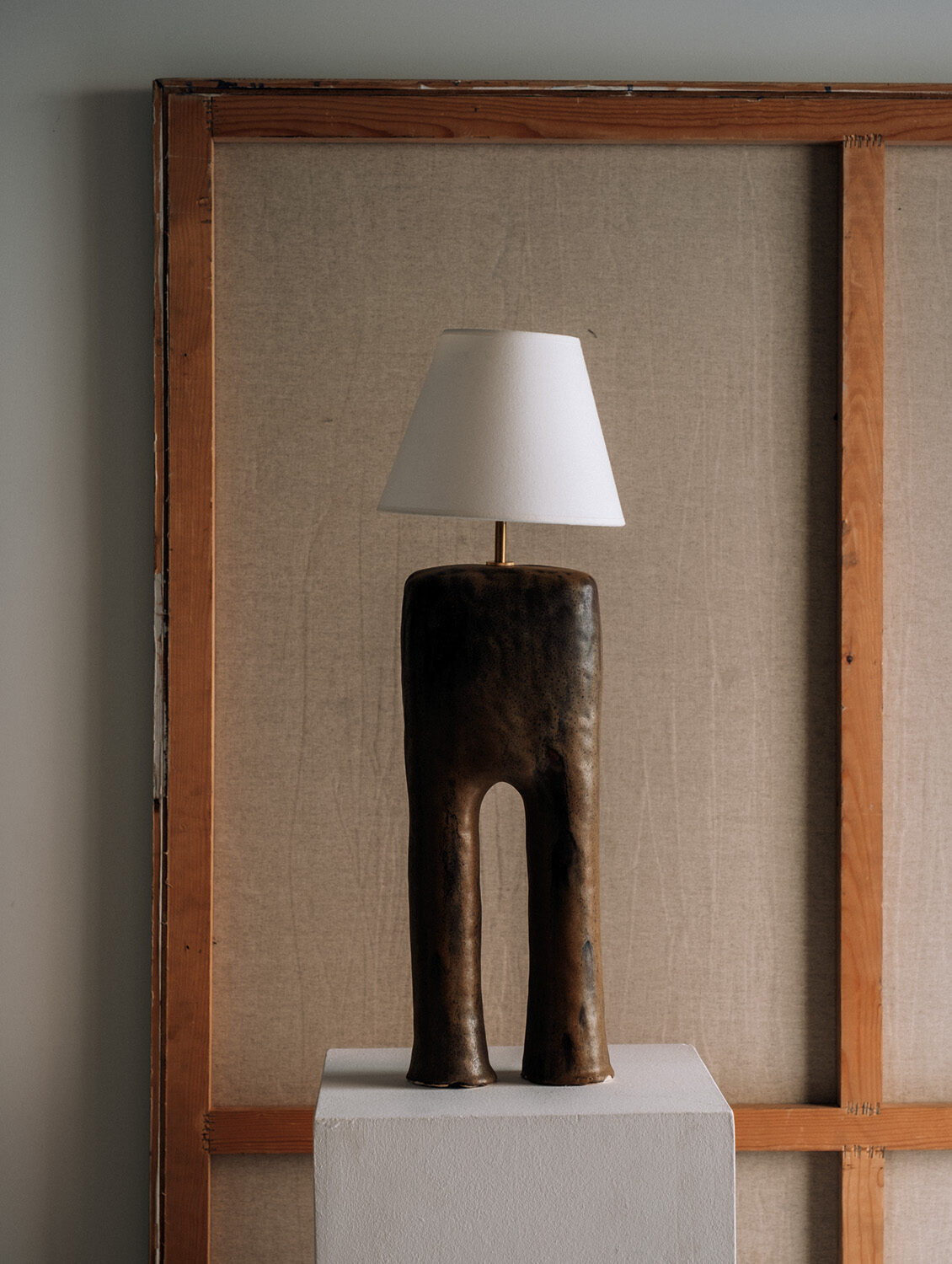 LAMP IV. Ceramic sculptural lamp, glazed piece in matte light brown color with nuances. Designer MARTA BONILLA. Brand APOLOGIA. Year 2023.
LAMP IV. Ceramic sculptural lamp, glazed piece in matte light brown color with nuances. Designer MARTA BONILLA. Brand APOLOGIA. Year 2023. In your interior design projects, you seek to connect the space with the most primal aspect of its location. How do you go about that search?
First, you have to interpret the space, the location, and the many factors that influence it, to then be able to develop the space’s own story. Fortunately, we have many clients who allow us to generate the storytelling from scratch and even want each space to have uniqueness. It’s something that keeps me alert and prevents me from getting bored.
How was the design and search for the current Cobalto Studio?
I found this place with the idea of having a more comfortable space to centralize the warehouse and the studio. Now we are much more focused on art direction, set design, interior architecture, and projects that are more related to the essence of the studio. The cataloging of the space and everything related to the archive is only 3% of what we do today.
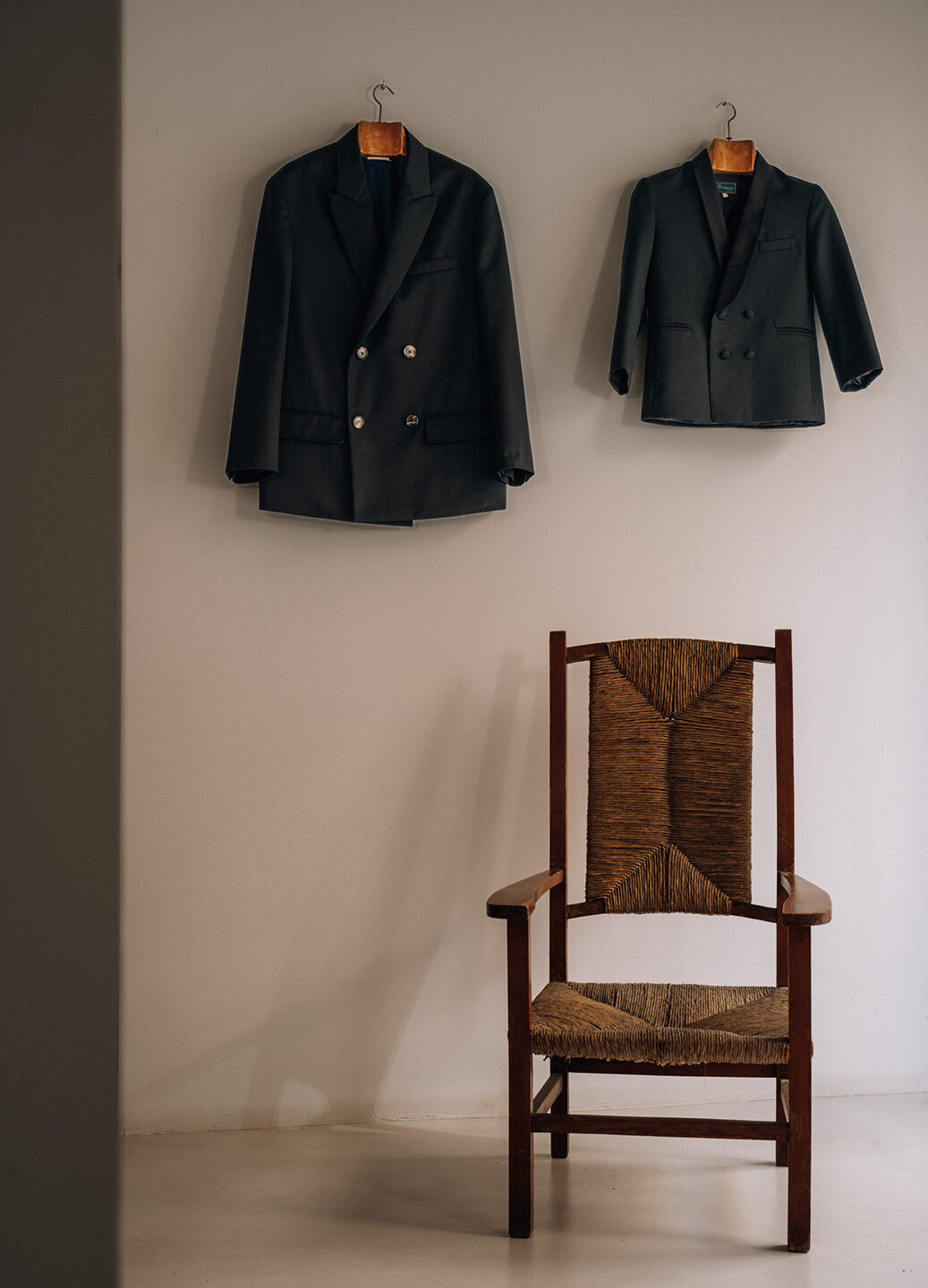 MY FIRST AND LATEST TUXEDO. It's my first and last morning coat. I found it interesting to compare them two. Year 1992-2022.
MY FIRST AND LATEST TUXEDO. It's my first and last morning coat. I found it interesting to compare them two. Year 1992-2022.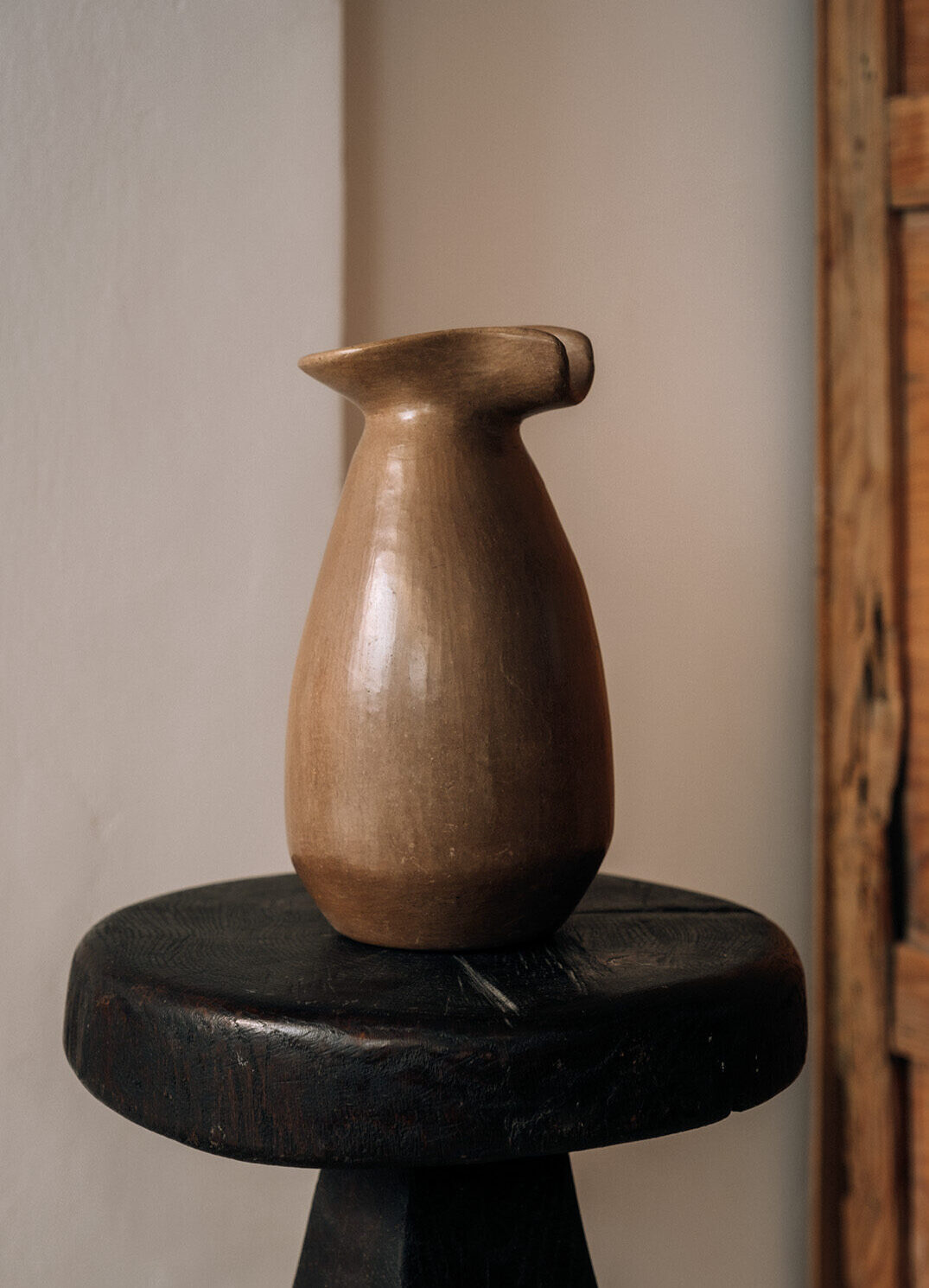 MEXICAN ARTISAN VASE. I bought is at the Tetetlan foundation in Pedregal, the shop next door to former Casa Prieto, the iconic house designed by Luis Barragán in 1947.
MEXICAN ARTISAN VASE. I bought is at the Tetetlan foundation in Pedregal, the shop next door to former Casa Prieto, the iconic house designed by Luis Barragán in 1947.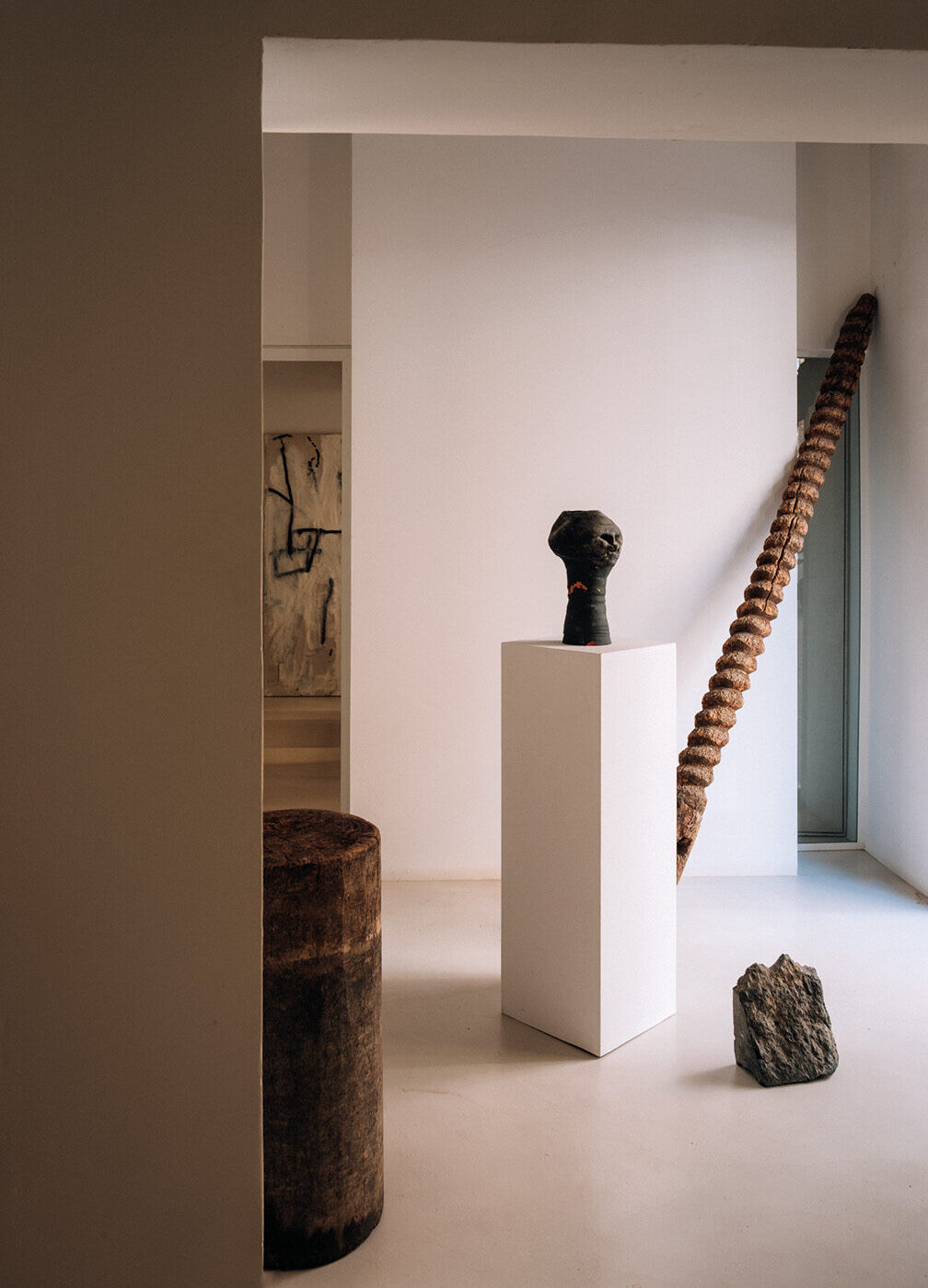 CAP BL 280.
Xavier Mañosa is a ceramist and industrial designer whose childhood took place among kilns of the family ceramic
workshop by his father Joan Mañosa. After graduating from the University he spent some time in Berlin and then returned to Barcelona and re-founded the family workshop under the name of Apparatu. Cap means head in Catalan and actually we have this traditional figure that's shaped as a big-headed. It is one of pieces in the studio that are more significant to me. Designer XAVIER MAÑOSA. Brand APPARATU. Year 2019.
CAP BL 280.
Xavier Mañosa is a ceramist and industrial designer whose childhood took place among kilns of the family ceramic
workshop by his father Joan Mañosa. After graduating from the University he spent some time in Berlin and then returned to Barcelona and re-founded the family workshop under the name of Apparatu. Cap means head in Catalan and actually we have this traditional figure that's shaped as a big-headed. It is one of pieces in the studio that are more significant to me. Designer XAVIER MAÑOSA. Brand APPARATU. Year 2019. When and how was La Cobalta born?
It started parallel to Cobalto and emerged to discuss topics that were the soul of Cobalto, generating a language that appeals to the poetic, the cultural, and the wildness of the Mediterranean coast.
There is a lot of poetry in your life. It is very present in your way of explaining your work, isn’t it?
I love reading poetry but poetry isn’t only written, you can find poetic elements in an act, in a light, in a photograph, in a person, in the way someone else speaks…
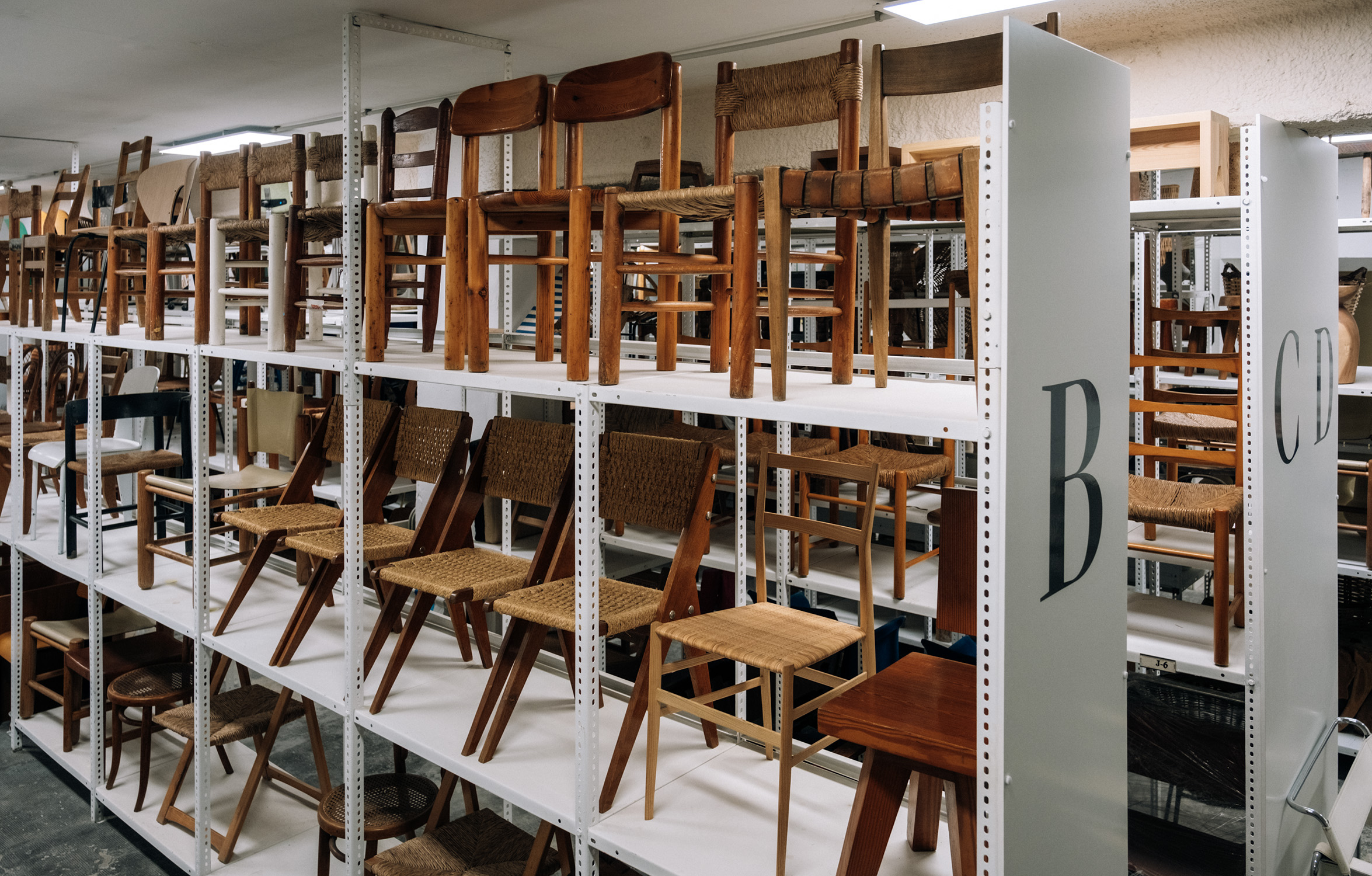
What projects do you enjoy the most now?
Well, I’m very happy with projects that are to generate spaces but where storytelling is very much linked. It’s much more fun because we can generate concepts linked to the overall image that don’t just involve space. It’s much richer, it’s more sociocultural.
How important is the beauty of what surrounds us? How does it influence our mood?
This journey we’re on here, at least in my case, if it isn’t surrounded by beauty, would probably lack meaning.
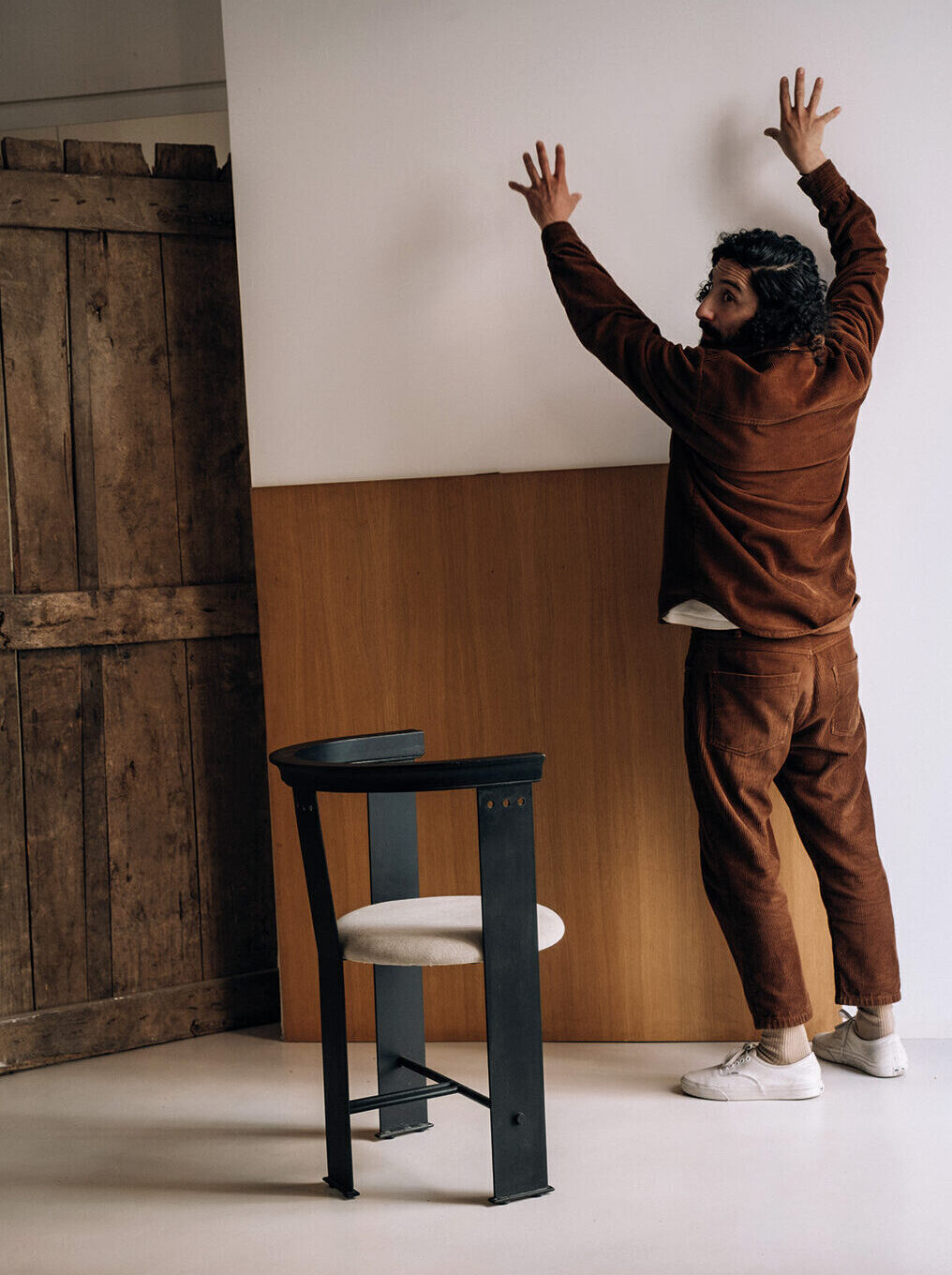 "NETWORK" CHAIR. Chair designed by the Barcelona architect and designer Alfredo Arribas, within the line of furniture designed for the "Network Café", which earned him the FAD interior design award in 1987. It reinterprets a piece created in 1908 by Eliel Saarinen, Eero's father. Designer ALFREDO ARRIBA. Brand ANTIGUES MATÈRIES. Year 1987.
"NETWORK" CHAIR. Chair designed by the Barcelona architect and designer Alfredo Arribas, within the line of furniture designed for the "Network Café", which earned him the FAD interior design award in 1987. It reinterprets a piece created in 1908 by Eliel Saarinen, Eero's father. Designer ALFREDO ARRIBA. Brand ANTIGUES MATÈRIES. Year 1987. 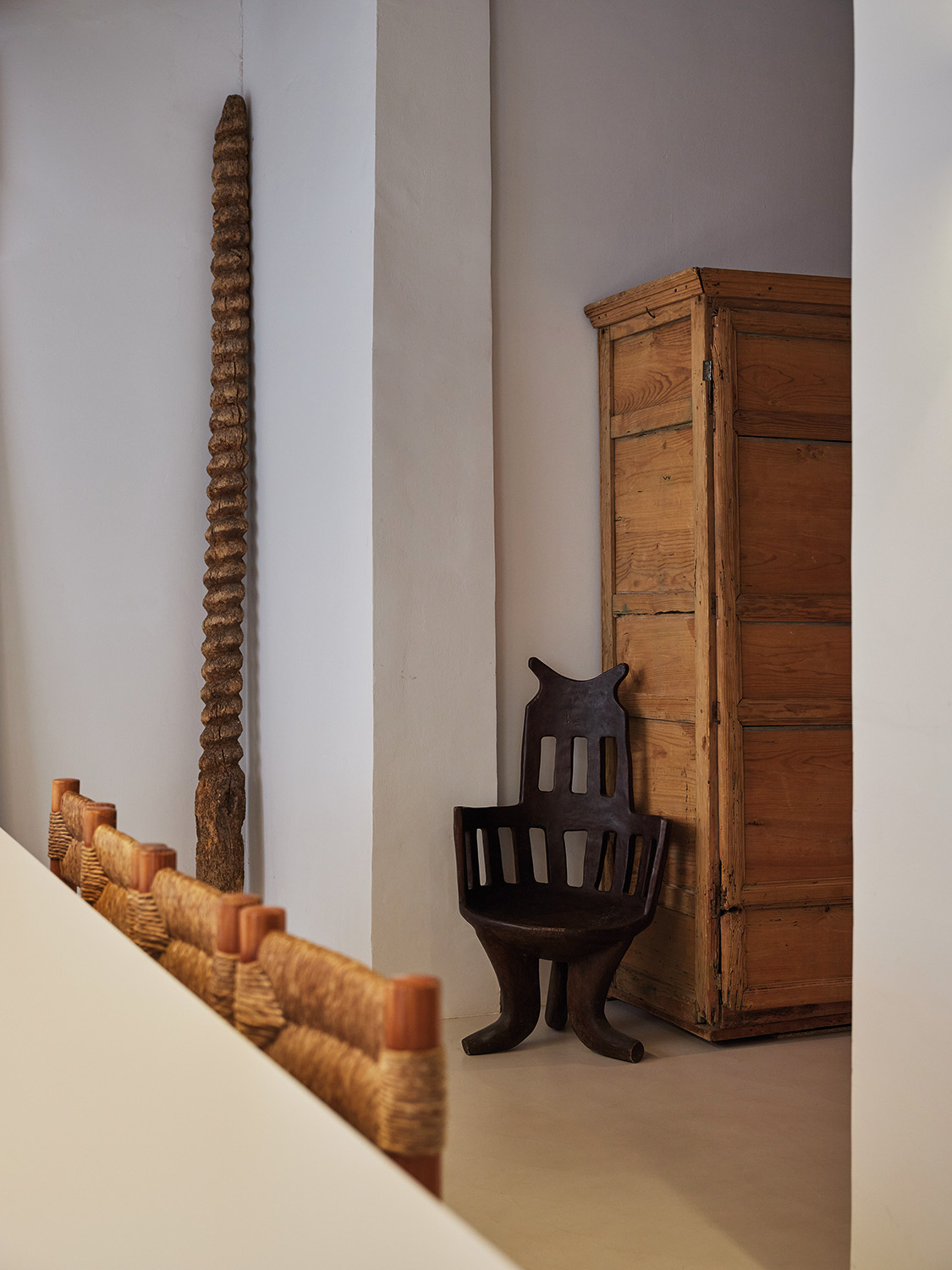
Is there any place that if you could collect, would be part of your ‘Selected by’?
One of the spaces that has given me the most Stendhal syndrome has been the Maeght Foundation. I think it’s the most barbaric and beautiful place I’ve ever been. I would love to live there. I like the materiality, the place, the vegetation, the art pieces… everything. I believe it’s the epitome of everything I expect from life.



